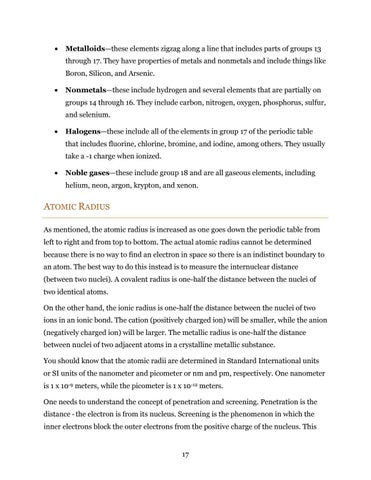•
Metalloids—these elements zigzag along a line that includes parts of groups 13 through 17. They have properties of metals and nonmetals and include things like Boron, Silicon, and Arsenic.
•
Nonmetals—these include hydrogen and several elements that are partially on groups 14 through 16. They include carbon, nitrogen, oxygen, phosphorus, sulfur, and selenium.
•
Halogens—these include all of the elements in group 17 of the periodic table that includes fluorine, chlorine, bromine, and iodine, among others. They usually take a -1 charge when ionized.
•
Noble gases—these include group 18 and are all gaseous elements, including helium, neon, argon, krypton, and xenon.
ATOMIC RADIUS As mentioned, the atomic radius is increased as one goes down the periodic table from left to right and from top to bottom. The actual atomic radius cannot be determined because there is no way to find an electron in space so there is an indistinct boundary to an atom. The best way to do this instead is to measure the internuclear distance (between two nuclei). A covalent radius is one-half the distance between the nuclei of two identical atoms. On the other hand, the ionic radius is one-half the distance between the nuclei of two ions in an ionic bond. The cation (positively charged ion) will be smaller, while the anion (negatively charged ion) will be larger. The metallic radius is one-half the distance between nuclei of two adjacent atoms in a crystalline metallic substance. You should know that the atomic radii are determined in Standard International units or SI units of the nanometer and picometer or nm and pm, respectively. One nanometer is 1 x 10-9 meters, while the picometer is 1 x 10-12 meters. One needs to understand the concept of penetration and screening. Penetration is the distance the electron is from its nucleus. Screening is the phenomenon in which the inner electrons block the outer electrons from the positive charge of the nucleus. This
17
